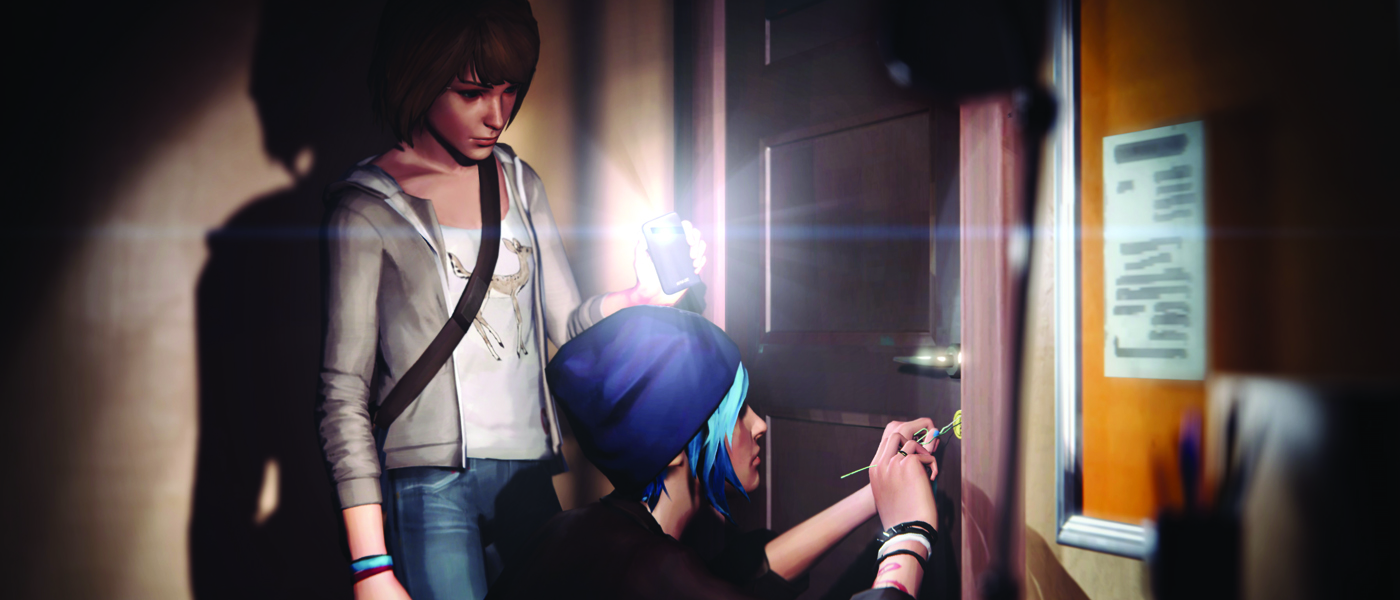Life Is Strange is a five part episodic series that will be delivered over the next few months. This review is for Episode 3, titled Chaos Theory. It will attempt to cover the value of Episode 3 both by itself and as part of a larger experience. More importantly, given how important the story is to experience Life Is Strange, this review is spoiler free but may contain light spoilers for the first two episodes. Life Is Strange follows Maxine Caulfield, or Max for short. Returning to her hometown of Arcadia Bay in Oregon, she enrols in a prestigious academy as senior photography student, working with some of the most prestigious in the business. The academy is rife with rumours and speculations regarding the mysterious disappearance of Rachel Amber, a girl whose reputation changes depending on who you talk to.
Life Is Strange follows Maxine Caulfield, or Max for short. Returning to her hometown of Arcadia Bay in Oregon, she enrols in a prestigious academy as senior photography student, working with some of the most prestigious in the business. The academy is rife with rumours and speculations regarding the mysterious disappearance of Rachel Amber, a girl whose reputation changes depending on who you talk to.
Without giving too much away, the events of Life Is Strange are thrust into motion when Max reunites with her estranged best friend, a more rebellious Chloe. Chloe’s father died the same year that Max left town, leading to the two becoming estranged. Max and Chloe both have a mutual goal, however, as both were involved with Rachel Amber, and as such, investigate her disappearance together. Whereas the last episode of Life Is Strange solely focused on conflicts within the student body of Blackwall Academy, Chaos Theory focuses on the bigger picture – which you’d expect given the episodes title. We’re almost past the halfway point in Life Is Strange and thankfully the stakes are really starting to ramp up.
Whereas the last episode of Life Is Strange solely focused on conflicts within the student body of Blackwall Academy, Chaos Theory focuses on the bigger picture – which you’d expect given the episodes title. We’re almost past the halfway point in Life Is Strange and thankfully the stakes are really starting to ramp up.
There’s not a lot that can be spoken about without absolutely ruining the episode for players, but things get interesting pretty fast especially as the consequences of all those choices made in the first two episodes begin to come full circle. And, as always, it ends with a killer pay-off. As the series continues, it has become apparent that not much is going to change in terms of presentation when it comes to Life Is Strange. The uniquely stylised visuals are still here – helping cement the games dreamlike, unapologetically indie flavour it employs in its presentation. The third episode continues this vibe pretty well although it does take place in some darker locales so it’s less of a showy episode, in terms of presentation.
As the series continues, it has become apparent that not much is going to change in terms of presentation when it comes to Life Is Strange. The uniquely stylised visuals are still here – helping cement the games dreamlike, unapologetically indie flavour it employs in its presentation. The third episode continues this vibe pretty well although it does take place in some darker locales so it’s less of a showy episode, in terms of presentation.
The usual issues that have plagued the first two episodes of Life Is Strange previously remain in the third episode. Character models look good but have a roughness to them saved only by the severely stylised artistic direction. Texture pop-ins, especially for scene transitions, remain an issue as you’d expect from any game running on the Unreal Engine. Lip-syncing remains atrocious too. But it’s becoming more and more clear that the priority with Life Is Strange is to provide a reasonably compelling gameplay experience married with an intense and interesting storyline, which the game and especially this episode is largely successful in doing.
But it’s becoming more and more clear that the priority with Life Is Strange is to provide a reasonably compelling gameplay experience married with an intense and interesting storyline, which the game and especially this episode is largely successful in doing.
A now standard mix of licensed and original music helps to hammer home the atmosphere too, and it’s nice to see the developer not skimping now that the series is more established and instead using whatever music they feel they should use in any specific moments of the episode. Episode 3 brings no surprises – Life Is Strange remains a pretty typical adventure game. There’s little action or combat in the game, but where previous episodes shied away from puzzles, the third episode includes quite a few. Most of them are fairly typical things you’d find in an adventure game like this – but something I like about Life Is Strange is that it embraces the fact that its puzzles are trial and error. It doesn’t pretend you’re not going to rewind time (literally or figuratively) and instead just lets you. Most of the puzzles are built on this mechanic, while the weaker ones are simply collection based fetch quests.
Episode 3 brings no surprises – Life Is Strange remains a pretty typical adventure game. There’s little action or combat in the game, but where previous episodes shied away from puzzles, the third episode includes quite a few. Most of them are fairly typical things you’d find in an adventure game like this – but something I like about Life Is Strange is that it embraces the fact that its puzzles are trial and error. It doesn’t pretend you’re not going to rewind time (literally or figuratively) and instead just lets you. Most of the puzzles are built on this mechanic, while the weaker ones are simply collection based fetch quests.
Similar to previous episodes, Max can both look at and interact with most things throughout the game world. The former option gives us her thoughts on whatever she’s looking at, while interaction helps to build character or even make choices that may have greater ramifications later on in the story. It’s simple since it means players can look into information about characters and their interactions at their own leisure, or simply plod through the main story and get to the end. Of course, as most players will be aware of now, most of the gameplay revolves around the concept of the Butterfly Effect – the idea that small changes can somehow largely influence the future and current events. Some of the changes are blatantly obvious – while others are more nuanced and won’t be explored later.
Of course, as most players will be aware of now, most of the gameplay revolves around the concept of the Butterfly Effect – the idea that small changes can somehow largely influence the future and current events. Some of the changes are blatantly obvious – while others are more nuanced and won’t be explored later.
Episode 3 provides some pretty interesting choices but many of them are blatantly black or white – there’s not a lot of grey ground here. Without spoiling, one asks players to take from one party to give to another, but one option is clearly the right one. Looking into the situation, there’s probably more to it than meets the eye, but at face value, there is seemingly one choice most players will make. It’ll be interesting to see if these choices pay off in future episodes but for now we’re just left wondering. The rewind mechanics are still prevalent here. Max can rewind time to explore different conversation options (especially if she stuffs up and makes someone angry at her) or to change the flow of events. The more interesting aspect of this mechanic is that Max herself, and all objects she interacts with, stay on her person. So you can grab something, rewind, and then move it somewhere else easily.
The rewind mechanics are still prevalent here. Max can rewind time to explore different conversation options (especially if she stuffs up and makes someone angry at her) or to change the flow of events. The more interesting aspect of this mechanic is that Max herself, and all objects she interacts with, stay on her person. So you can grab something, rewind, and then move it somewhere else easily.
Episode 3 of Life Is Strange definitely plays with this mechanic a lot more than the first two episodes. Max will be required to explore all conversation options, use these conversation options to bribe or persuade others to talk to her, or even move items to prevent certain events from happening. Some of the puzzles in particular are purposefully obtuse, but honestly they’re also pretty satisfying to solve. It’s rare that games truly reward players for thinking outside of the box but thankfully Life Is Strange does it well. As per usual, exploring the menus and the journals and text messages provides extraneous information about the characters and what they’re going through as well as how they’ve reacted to the previous episode’s events. It gives a great sense of life to the game’s world, but at the same time isn’t necessarily pertinent information required to proceed. As usual, this episode feels well-paced and doesn’t outstay its welcome nor does it feel like it short changes the player either, especially if they stop to take in everything the world has to offer.
As per usual, exploring the menus and the journals and text messages provides extraneous information about the characters and what they’re going through as well as how they’ve reacted to the previous episode’s events. It gives a great sense of life to the game’s world, but at the same time isn’t necessarily pertinent information required to proceed. As usual, this episode feels well-paced and doesn’t outstay its welcome nor does it feel like it short changes the player either, especially if they stop to take in everything the world has to offer. But while I end every review of every episode of Life Is Strange with this thought, it’s one that still remains interesting. Just how will Life Is Strange manage to wrap up all these strange kinds of mysteries about its characters? Some of the decisions and their outcomes in this episode highlights an almost dramatic shift in tone for the remainder of the series. We can only wait to see how things play out, given the choices and opportunities available.
But while I end every review of every episode of Life Is Strange with this thought, it’s one that still remains interesting. Just how will Life Is Strange manage to wrap up all these strange kinds of mysteries about its characters? Some of the decisions and their outcomes in this episode highlights an almost dramatic shift in tone for the remainder of the series. We can only wait to see how things play out, given the choices and opportunities available.
But it’s really freaking exciting, none the less.



